A Depression Diagnosis Method Based on the Hybrid Neural Network and Attention Mechanism
Abstract
:1. Introduction
2. Materials and Methods
2.1. Data Sources and Data Preprocessing
- MODMA dataset
- Private dataset
2.2. Model Preparation
2.2.1. CNN
2.2.2. GRU
2.2.3. Attention Mechanism
2.2.4. Proposed Depression Diagnosis Approach
- (1)
- Network parameter tuning
- (2)
- Hyperparameter tuning
3. Results
3.1. Diagnosis Process
- Step 1:
- Collecting and labeling the EEG signals of different subjects to form a dataset.
- Step 2:
- Preprocessing and extracting features of EEG signals.
- Step 3:
- Dividing the dataset into the training set, validation set, and test set to evaluate the performance of the depression diagnosis model.
- Step 4:
- Training the network model and saving it.
- Step 5:
- Verifying the effectiveness and sensitivity of the algorithm. The performance of the depression diagnosis model is evaluated based on the predicted and true labels.
3.2. Evaluation Metrics
- (1)
- Accuracy [46] is defined as the ratio of the number of correctly classified samples to the total sample for a given test dataset.
- (2)
- Precision [47] is the ratio of the number of correctly classified positive samples to the number of classified positive samples.
- (3)
- Recall [47] is the ratio of the number of correctly classified positive samples to the actual number of positive samples.
- (4)
- F1 score [48] is to evaluate the pros and cons of different algorithms. On the basis of precision and recall, the concept of F1 value is proposed to evaluate precision and recall as a whole.where TP, FP, TN, and FN represent true positive, false positive, true negative, and false negative, respectively. True positives represent the number of samples predicted to be depression that are actually depression. False positives represent the number of samples predicted to be depressed that are actually healthy. True negatives represent the number of samples predicted to be healthy that are actually healthy. False negatives represent the number of samples predicted to be healthy that are actually depressed.
3.3. Experimental Result
- (1)
- Experimental results and analysis of the MODMA dataset
- (2)
- Experimental results and analysis of the private dataset
4. Discussion
5. Conclusions
Author Contributions
Funding
Institutional Review Board Statement
Informed Consent Statement
Data Availability Statement
Conflicts of Interest
References
- World Federation for Mental Health. Depression: A Global Crisis; World Federation for Mental Health: Occoquan, VA, USA, 2012. [Google Scholar]
- World Health Organization. Depression and Other Common Mental Disorders: Global Health Estimates; Technical Report; World Health Organization: Geneva, Switzerland, 2017. [Google Scholar]
- Friedrich, M.J. Depression is the leading cause of disability around the world. JAMA 2017, 317, 1517. [Google Scholar] [CrossRef] [PubMed]
- Jordan, K. World Mental Health Day 2012—Depression a Global Crisis; World Health Organization: Geneva, Switzerland, 2012. [Google Scholar]
- Zung, W.W.K. A self-rating depression scale. Arch. Gen. Psychiatry 1965, 12, 63–70. [Google Scholar] [CrossRef]
- Beck, A.T.; Steer, R.A. Comparison of Beck Depression Inventories-IA and-II in Psychiatric Outpatients. J. Personal. Assess. 1996, 67, 588–597. [Google Scholar] [CrossRef] [PubMed]
- Jur Jurysta, F.; Kempenaers, C.; Lancini, J.; Lanquart, J.P.; Van De Borne, P.; Linkowski, P. Altered interaction between cardiac vagal influence and delta sleep eeg suggests an altered neuroplasticity in patients suffering from major depressive disorder. Acta Psychiatr. Scand. 2010, 121, 236–239. [Google Scholar] [CrossRef] [PubMed]
- Saeidi, M.; Karwowski, W.; Farahani, F.V.; Fiok, K.; Taiar, R.; Hancock, P.A.; Al-Juaid, A. Neural Decoding of EEG Signals with Machine Learning: A Systematic Review. Brain Sci. 2021, 11, 1525. [Google Scholar] [CrossRef] [PubMed]
- Sharma, M.; Achuth, P.V.; Deb, D.; Puthankattil, S.D.; Acharya, U.R. An Automated Diagnosis of Depression Using Three-Channel Bandwidth-Duration Localized Wavelet Filter Bank with EEG Signals. Cogn. Syst. Res. 2018, 52, 508–520. [Google Scholar] [CrossRef]
- Berger, H. Ueber das Elektrenkephalogram des Menschen. 5th communication. Arch Psychiat Nervenkr 1932, 98, 231–254. [Google Scholar] [CrossRef]
- Gao, Y.; Cao, Z.; Liu, J.; Zhang, J. A novel dynamic brain network in arousal for brain states and emotion analysis. Math. Biosci. Eng. 2021, 18, 7440–7463. [Google Scholar] [CrossRef]
- Campisi, P.; La Rocca, D. Brain waves for automatic biometric-based user recognition. IEEE Trans. Inform. Forensics Secur. 2014, 9, 782–800. [Google Scholar] [CrossRef]
- Koller-Schlaud, K.; Ströhle, A.; Bärwolf, E.; Behr, J.; Rentzsch, J. EEG frontal asymmetry and theta power in unipolar and bipolar depression. J. Affect. Disord. 2020, 276, 501–510. [Google Scholar] [CrossRef]
- Kang, M.; Kwon, H.; Park, J.H.; Kang, S.; Lee, Y. Deep-asymmetry: Asymmetry matrix image for deep learning method in pre-screening depression. Sensors 2020, 20, 6526. [Google Scholar] [CrossRef] [PubMed]
- Liu, W.; Zhang, C.; Wang, X.; Xu, J.; Chang, Y.; Ristaniemi, T.; Cong, F. Functional connectivity of major depression disorder using ongoing EEG during music perception. Clin. Neurophysiol. 2020, 131, 2413–2422. [Google Scholar] [CrossRef] [PubMed]
- Erguzel, T.T.; Ozekes, S. Feature selection and classification of electroencephalographic signals: An artificial neural network and genetic algorithm based approach. Clin. EEG Neurosci. 2015, 46, 321–326. [Google Scholar] [CrossRef]
- Hosseinifard, B.; Moradi, M.H.; Rostami, R. Classifying depression patients and normal subjects using machine learning techniques and nonlinear features from EEG signal. Comput. Methods Programs Biomed. 2013, 109, 339–345. [Google Scholar] [CrossRef]
- Mumtaz, W.; Xia, L.; Ali, S.S.A. Electroencephalogram (EEG)-based computer-aided technique to diagnose major depressive disorder (MDD). Biomed. Signal Processing Control. 2017, 31, 108–115. [Google Scholar] [CrossRef]
- Liao, S.C.; Wu, C.T.; Huang, H.C.; Cheng, W.T.; Liu, Y.H. Major depression detection from EEG signals using kernel eigen-filter-bank common spatial patterns. Sensors 2017, 17, 1385. [Google Scholar] [CrossRef] [Green Version]
- Mohammadi, Y.; Hajian, M.; Moradi, M.H. Discrimination of depression levels using machine learning methods on EEG signals. In Proceedings of the 2019 27th Iranian Conference on Electrical Engineering (ICEE), Yazd, Iran, 30 April–2 May 2019; pp. 1765–1769. [Google Scholar]
- Zhang, Q.; Yang, L.T.; Chen, Z. Deep computation model for unsupervised feature learning on big data. IEEE Trans Serv. Comput. 2016, 9, 161–171. [Google Scholar] [CrossRef]
- Acharya, U.R.; Oh, S.L.; Hagiwara, Y. Automated EEG-based screening of depression using deep convolutional neural network. Comput. Methods Programs Biomed. 2018, 161, 103–113. [Google Scholar] [CrossRef]
- Nagabushanam, P.; George, S.T.; Radha, S. EEG signal classification using LSTM and improved neural network algorithms. Soft Comput. 2020, 24, 9981–10003. [Google Scholar] [CrossRef]
- Ay, B.; Yildirim, O.; Talo, M. Automated depression detection using deep representation and sequence learning with EEG signals. J. Med. Syst. 2019, 43, 1–12. [Google Scholar] [CrossRef]
- Cai, H.; Gao, Y.; Sun, S. MODMA dataset: A Multi-model Open Dataset for Mental- disorder Analysis. arXiv 2002, arXiv:2002.09283. [Google Scholar]
- Akar, S.A.; Kara, S.; Agambayev, S. Nonlinear analysis of EEGs of patients with major depression during different emotional states. Comput. Biol. Med. 2015, 67, 49–60. [Google Scholar] [CrossRef] [PubMed]
- Available online: https://www.diytdcs.com/2012/07/1020-system-electrode-distances (accessed on 22 July 2021).
- Widmann, A.; Schröger, E.; Maess, B. Digital filter design for electrophysiological data–a practical approach. J. Neurosci. Methods 2015, 250, 34–46. [Google Scholar] [CrossRef] [Green Version]
- Çınar, S. Design of an automatic hybrid system for removal of eye-blink artifacts from EEG recordings. Biomed. Signal Processing Control. 2021, 67, 102543. [Google Scholar] [CrossRef]
- Li, Y.; Wang, P.T.; Vaidya, M.P.; Flint, R.D.; Liu, C.Y.; Slutzky, M.W.; Do, A.H. Electromyogram (EMG) Removal by Adding Sources of EMG (ERASE)—A novel ICA-based algorithm for removing myoelectric artifacts from EEG. Front. Neurosci. 2021, 14, 597941. [Google Scholar] [CrossRef]
- Alam, R.; Zhao, H.; Goodwin, A. Differences in power spectral densities and phase quantities due to processing of eeg signals. Sensors 2020, 20, 6285. [Google Scholar] [CrossRef] [PubMed]
- Tang, R.; Chen, T. Changes of Brain Structure and Function in Children and Adolescents with depression and Its Clinical Application. In Proceedings of the 20th National Academic Congress of Pyschology, Rome, Italy, 7–8 August 2017. [Google Scholar]
- Hasan, M.J.; Shon, D.; Im, K.; Choi, H.K.; Yoo, D.S.; Kim, J.M. Sleep state classification using power spectral density and residual neural network with multichannel EEG signals. Appl. Sci. 2020, 10, 7639. [Google Scholar] [CrossRef]
- Wei, B.N.; Saidatul, A. PSD-Based Features Extraction For EEG Signal During Typing Task. IOP Conf. Ser. Mater. Sci. Eng. 2019, 557, 012032. [Google Scholar]
- LeCun, Y.; Boser, B.; Denker, J. Handwritten digit recognition with a back-propagation network. Adv. Neural Inf. Processing Syst. 1989, 2. [Google Scholar]
- Schmidhuber, J. Deep learning in neural networks: An overview. Neural Netw. 2015, 61, 85–117. [Google Scholar] [CrossRef] [Green Version]
- Hochreiter, S.; Schmidhuber, J. Long short-term memory. Neural Comput. 1997, 9, 1735–1780. [Google Scholar] [CrossRef] [PubMed]
- Chung, J.; Gulcehre, C.; Cho, K.H. Empirical evaluation of gated recurrent neural networks on sequence modeling. arXiv 2014, arXiv:1412.3555. [Google Scholar]
- Cho, K.; Van Merriënboer, B.; Gulcehre, C. Learning phrase representations using RNN encoder-decoder for statistical machine translation. arXiv 2014, arXiv:1406.1078. [Google Scholar]
- Rana, R. Gated recurrent unit (GRU) for emotion classification from noisy speech. arXiv 2016, arXiv:1612.07778. [Google Scholar]
- Bahdanau, D.; Cho, K.; Bengio, Y. Neural machine translation by jointly learning to align and translate. arXiv 2014, arXiv:1409.0473. [Google Scholar]
- Nath, B.; Sarkar, S.; Das, S. Neural machine translation for Indian language pair using hybrid attention mechanism. Innov. Syst. Softw. Eng. 2022, 1–9. [Google Scholar] [CrossRef]
- Li, C.; Wang, B.; Zhang, S. Emotion recognition from EEG based on multi-task learning with capsule network and attention mechanism. Comput. Biol. Med. 2022, 143, 105303. [Google Scholar] [CrossRef]
- Abiyev, R.; Arslan, M. Identification of epileptic EEG signals using convolutional neural networks. Appl. Sci. 2020, 10, 4089. [Google Scholar] [CrossRef]
- Glorot, X.; Bordes, A.; Bengio, Y. Deep sparse rectifier neural networks. In Proceedings of the Fourteenth International Conference on Artificial Intelligence and Statistics, JMLR Workshop and Conference Proceedings, Fort Lauderdale, FL, USA, 11–13 April 2011; pp. 315–323. [Google Scholar]
- Swets, J.A. Measuring the accuracy of diagnostic systems. Science 1988, 240, 1285–1293. [Google Scholar] [CrossRef] [Green Version]
- Deng, H.; Wang, Y.; Mang, M. Relationship between recall and precision ratio in terms of retrieval example. J. China Soc. Sci. Tech. Inf. 2000, 19, 237–241. [Google Scholar]
- Fujino, A.; Isozaki, H.; Suzuki, J. Multi-label text categorization with model combination based on f1-score maximization. In Proceedings of the Third International Joint Conference on Natural Language Processing: Volume-II, Hyderabad, India, 7–12 January 2008. [Google Scholar]
- Sun, S.; Li, J.; Chen, H.; Gong, T.; Li, X.; Hu, B. A study of resting-state EEG biomarkers for depression recognition. arXiv 2020, arXiv:2002.11039. [Google Scholar]
- Wang, Y.; Liu, F.; Yang, L. EEG-Based Depression Recognition Using Intrinsic Time-scale Decomposition and Temporal Convolution Network. In Proceedings of the Fifth International Conference on Biological Information and Biomedical Engineering, Hangzhou, China, 20–22 July 2021. [Google Scholar]

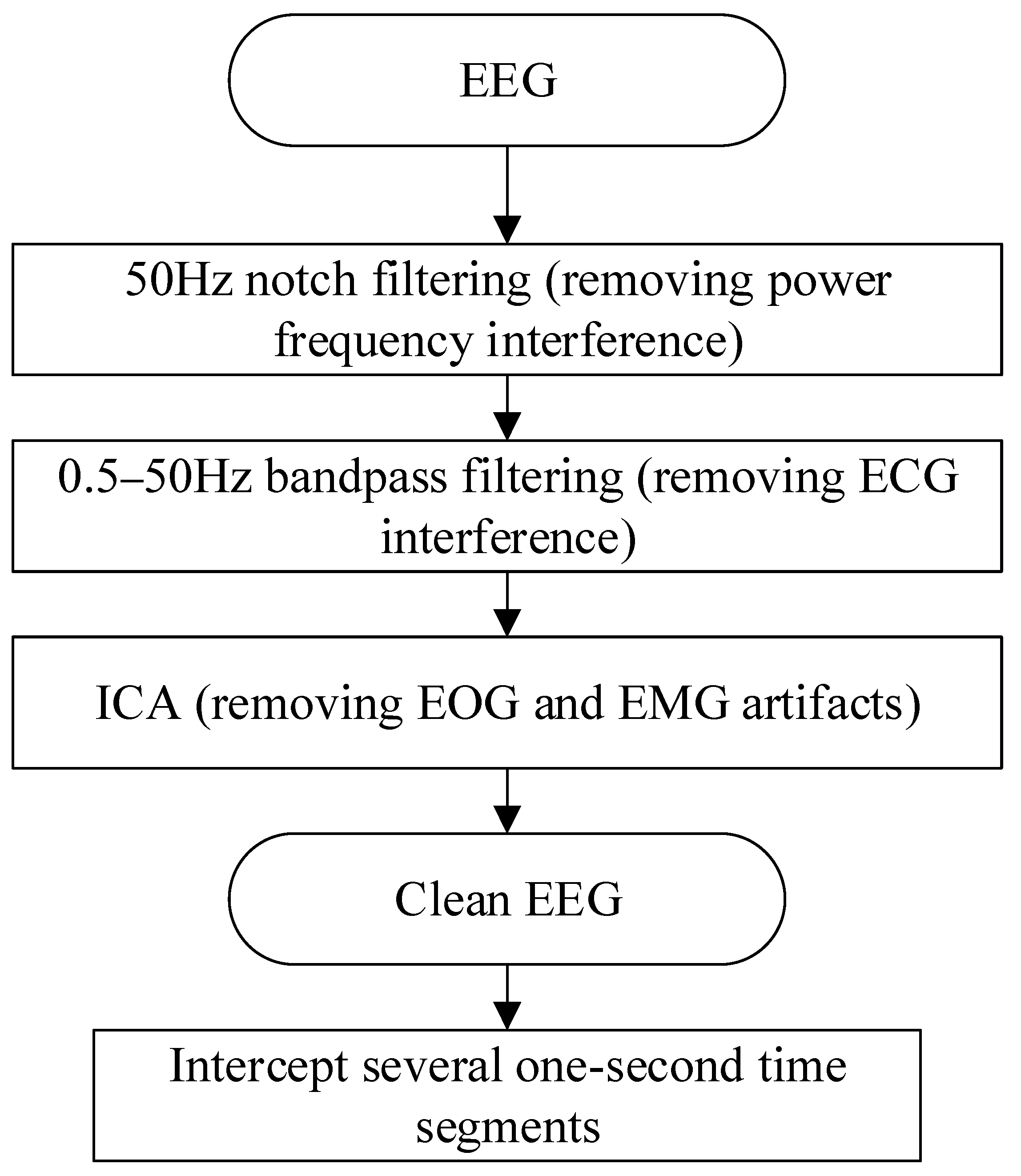


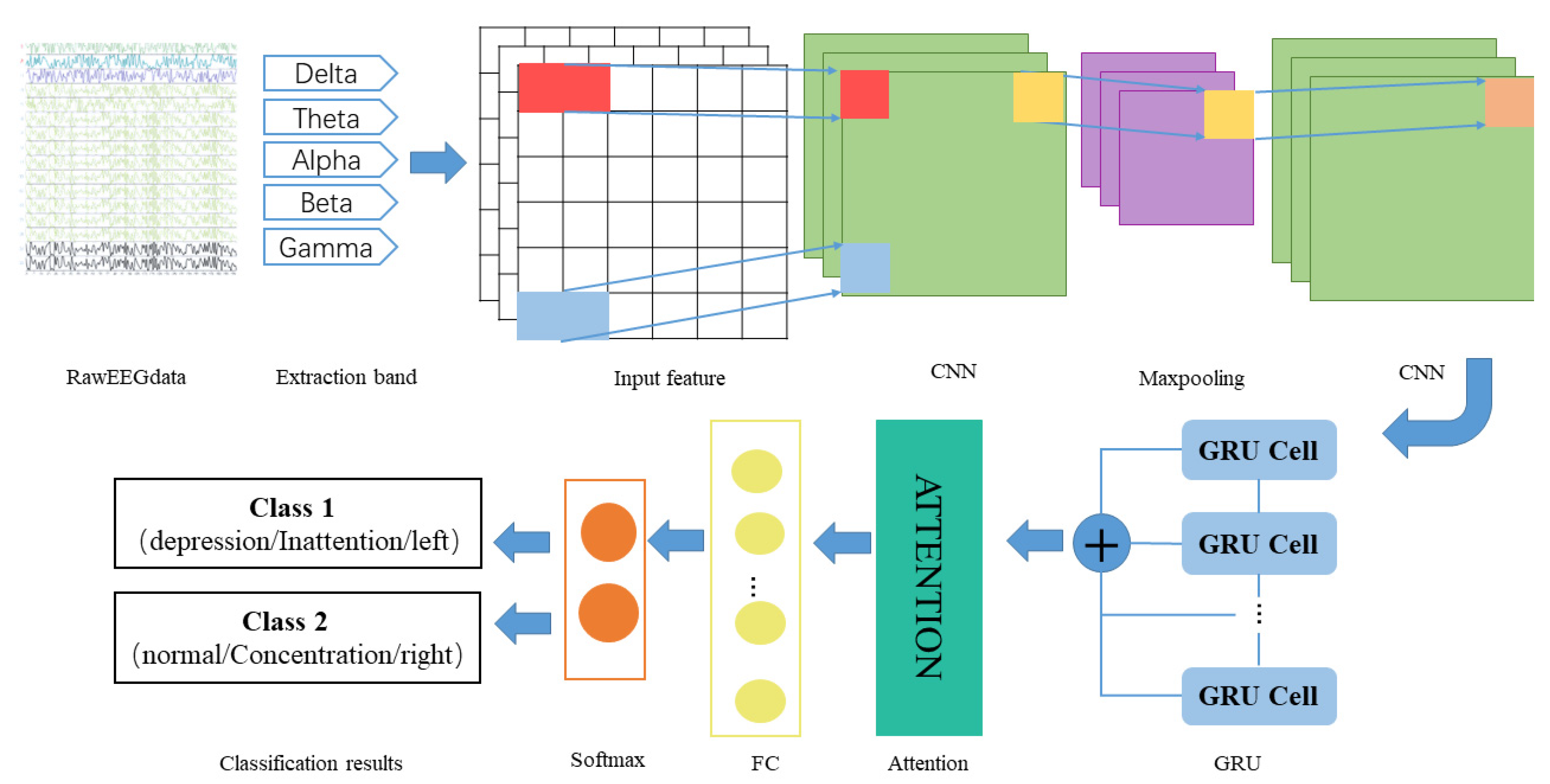

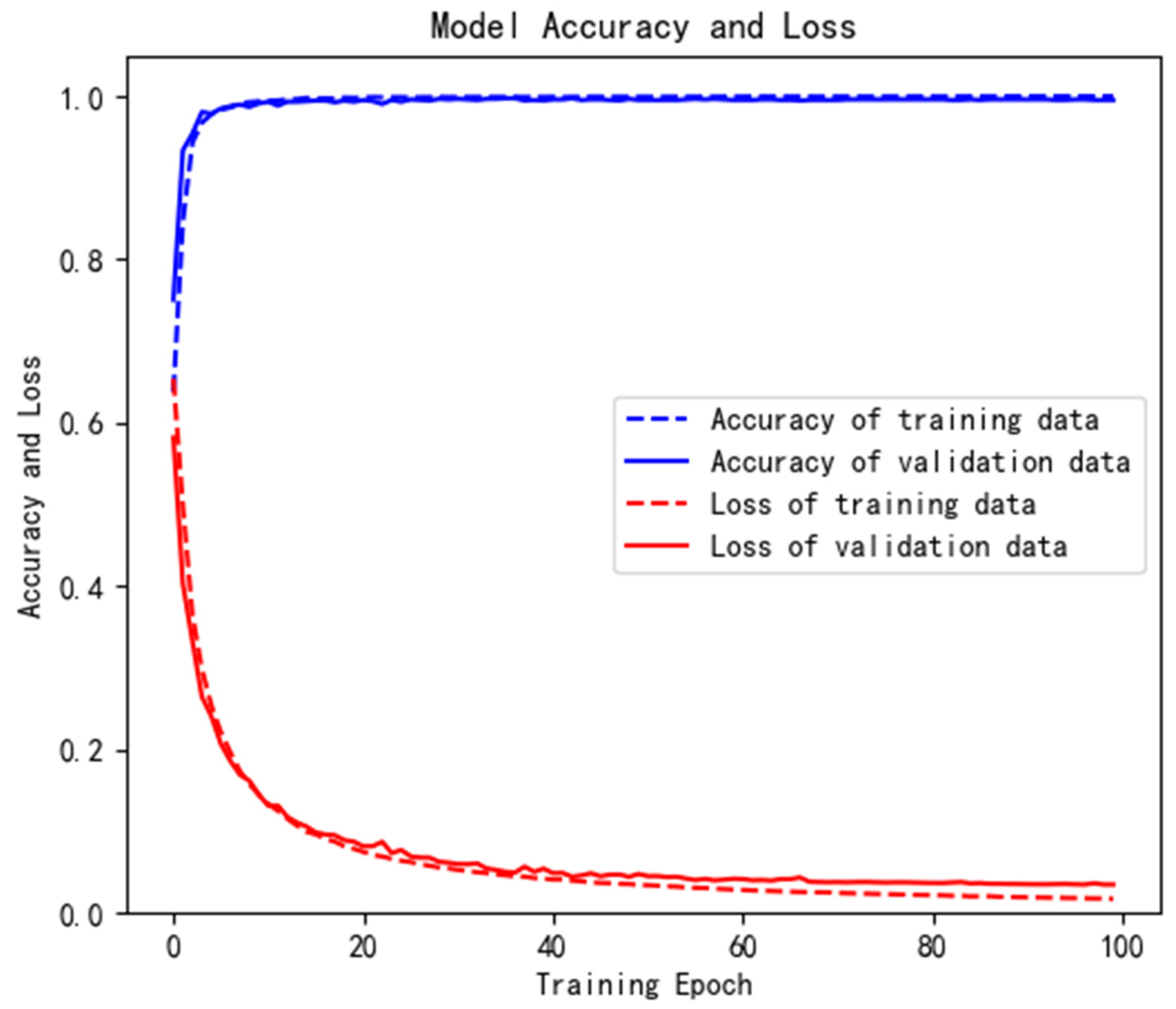

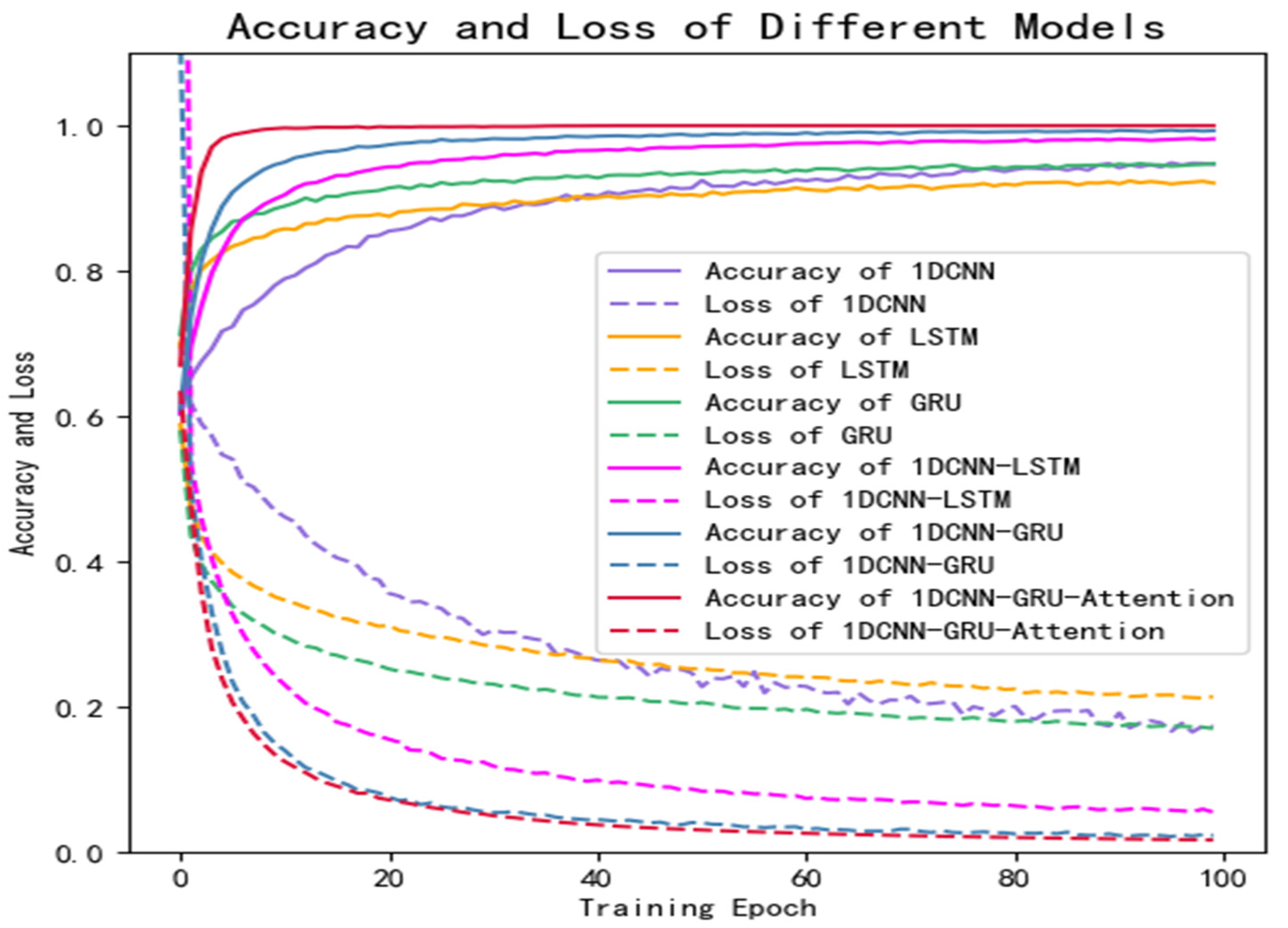
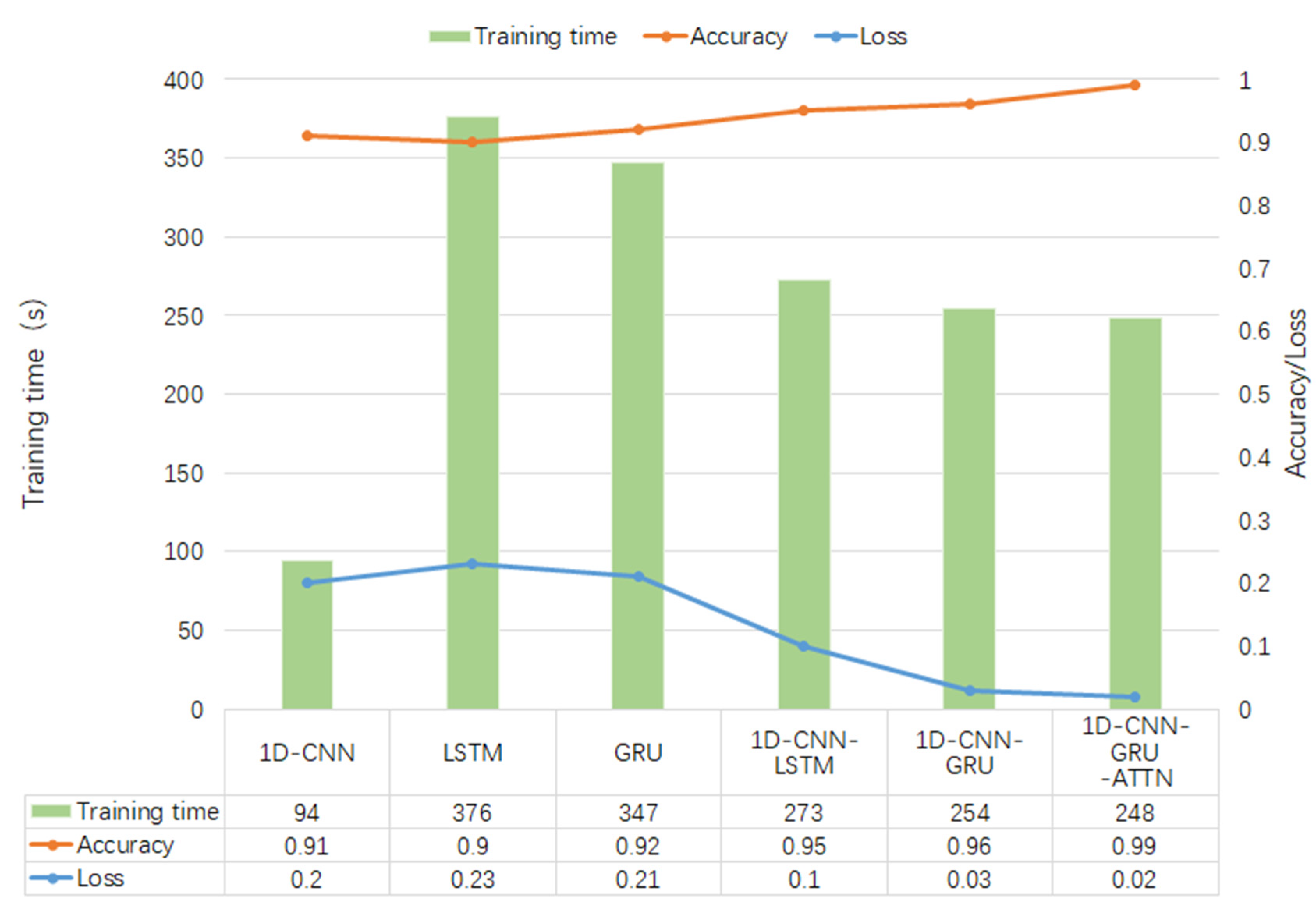
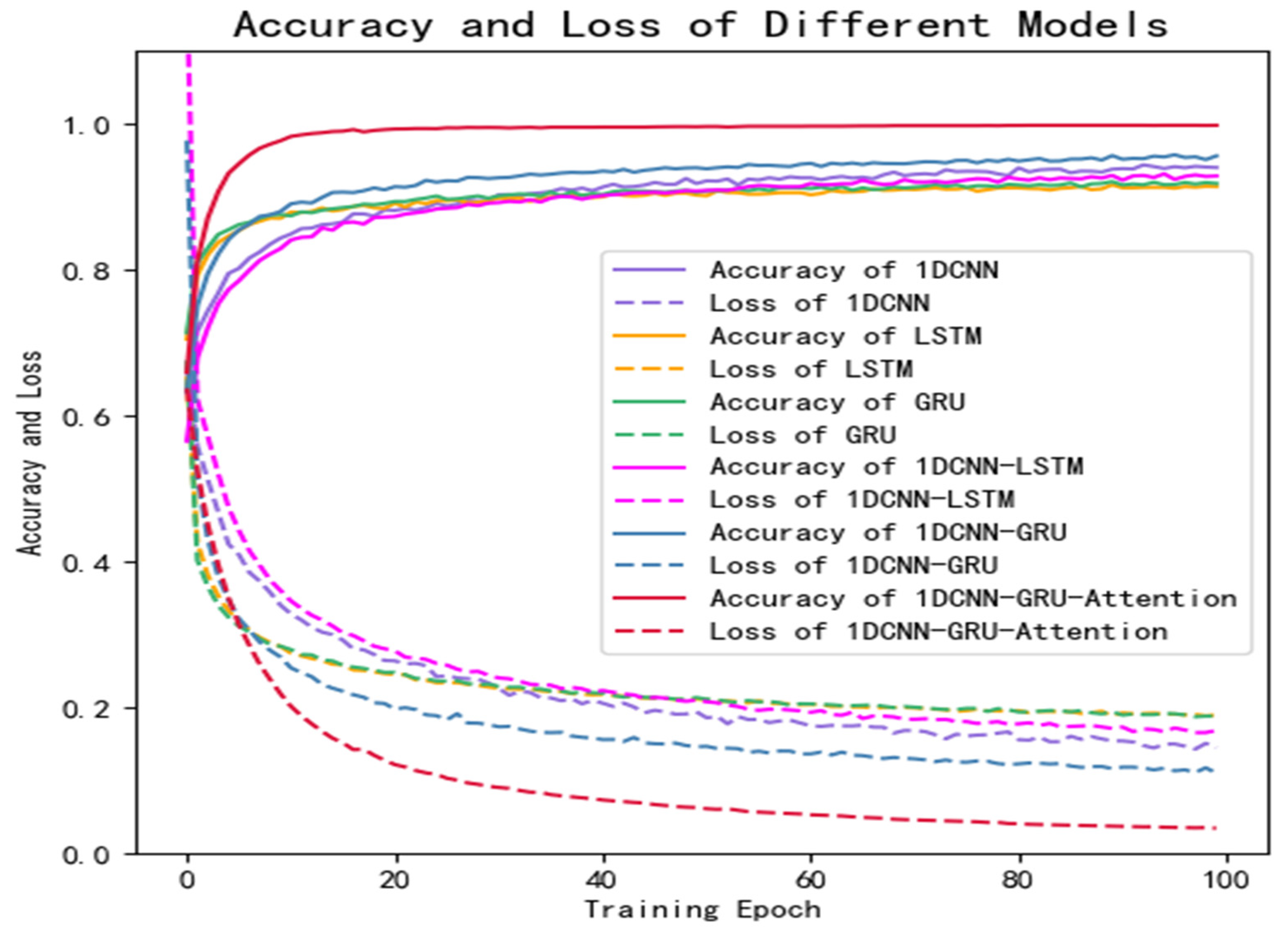
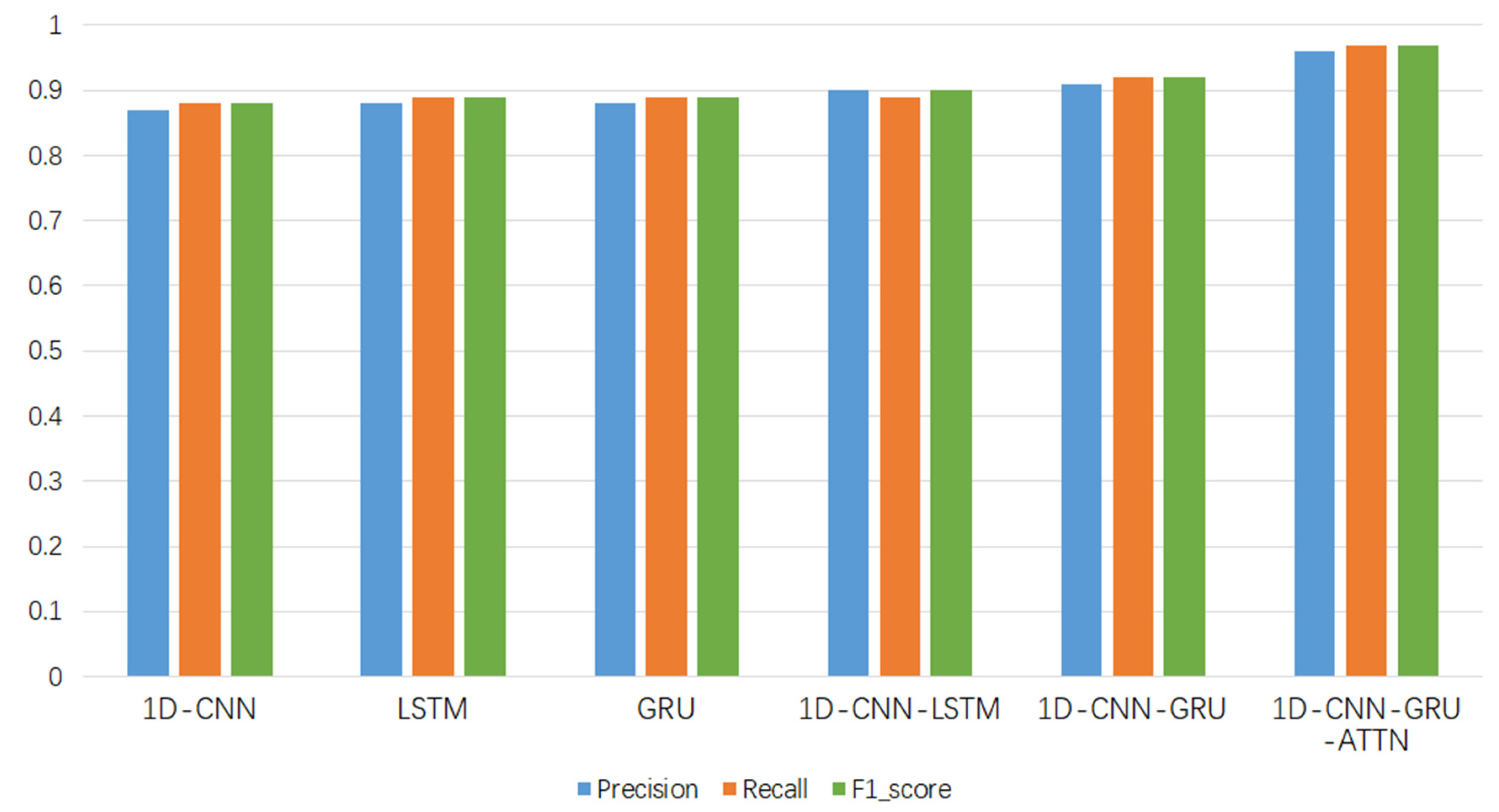
| Dataset | Properties | Values |
|---|---|---|
| Public Dataset (MODMA) | Number of subjects | 53 |
| Number of subjects with depression | 24 | |
| Male/female ratio | 33/20 | |
| Number of channels | 128 | |
| Sampling rate (Hz) | 250 | |
| Private Dataset | Number of subjects | 32 |
| Number of subjects with depression | 16 | |
| Male/female ratio | 16/16 | |
| Number of channels | 16 | |
| Sampling rate (Hz) | 250 |
| Model | NFC_1 | NFC_2 | KSC | NNG | ACC | Loss |
|---|---|---|---|---|---|---|
| M1 | 128 | 128 | 3 | 64 | 0.75 | 0.38 |
| M2 | 128 | 128 | 3 | 128 | 0.75 | 0.31 |
| M3 | 128 | 128 | 3 | 256 | 0.79 | 0.30 |
| M4 | 128 | 256 | 3 | 64 | 0.77 | 0.31 |
| M5 | 128 | 256 | 3 | 128 | 0.77 | 0.32 |
| M6 | 128 | 256 | 3 | 256 | 0.75 | 0.29 |
| M7 | 256 | 128 | 3 | 64 | 0.76 | 0.34 |
| M8 | 256 | 128 | 3 | 128 | 0.75 | 0.33 |
| M9 | 256 | 128 | 3 | 256 | 0.75 | 0.38 |
| M10 | 256 | 256 | 3 | 64 | 0.74 | 0.36 |
| M11 | 256 | 256 | 3 | 128 | 0.75 | 0.35 |
| M12 | 256 | 256 | 3 | 256 | 0.75 | 0.28 |
| M13 | 128 | 128 | 5 | 64 | 0.87 | 0.21 |
| M14 | 128 | 128 | 5 | 128 | 0.88 | 0.20 |
| M15 | 128 | 128 | 5 | 256 | 0.89 | 0.19 |
| M16 | 128 | 256 | 5 | 64 | 0.90 | 0.27 |
| M17 | 128 | 256 | 5 | 128 | 0.89 | 0.17 |
| M18 | 128 | 256 | 5 | 256 | 0.92 | 0.16 |
| M19 | 256 | 128 | 5 | 64 | 0.89 | 0.23 |
| M20 | 256 | 128 | 5 | 128 | 0.89 | 0.17 |
| M21 | 256 | 128 | 5 | 256 | 0.91 | 0.19 |
| M22 | 256 | 256 | 5 | 64 | 0.89 | 0.21 |
| M23 | 256 | 256 | 5 | 128 | 0.90 | 0.18 |
| M24 | 256 | 256 | 5 | 256 | 0.91 | 0.17 |
| Network Parameters | Model | Epoch | Batch Size | Accuracy |
|---|---|---|---|---|
| M18 | M1 | 80 | 128 | 0.9776 |
| M2 | 90 | 128 | 0.9760 | |
| M3 | 100 | 128 | 0.9770 | |
| M4 | 80 | 256 | 0.9780 | |
| M5 | 90 | 256 | 0.9753 | |
| M6 | 100 | 256 | 0.9797 | |
| M21 | M7 | 80 | 128 | 0.9530 |
| M8 | 90 | 128 | 0.9532 | |
| M9 | 100 | 128 | 0.9541 | |
| M10 | 80 | 256 | 0.9523 | |
| M11 | 90 | 256 | 0.9537 | |
| M12 | 100 | 256 | 0.9548 | |
| M24 | M13 | 80 | 128 | 0.9533 |
| M14 | 90 | 128 | 0.9531 | |
| M15 | 100 | 128 | 0.9536 | |
| M16 | 80 | 256 | 0.9540 | |
| M17 | 90 | 256 | 0.9542 | |
| M18 | 100 | 256 | 0.9547 |
| Dataset | Depression | Normal | Samples |
|---|---|---|---|
| MODMA | 7200 | 8700 | 15,900 |
| Private dataset | 4119 | 3114 | 7533 |
| Description | Value |
|---|---|
| Number of filters in convolutional layer 1 | 128 |
| Number of filters in convolutional layer 2 | 256 |
| Filter size in convolutional layers 1 and 2 | 5 |
| Pooling size in the max pooling layer | 2 |
| Number of neurons in GRU | 256 |
| Dropout | 0.2 |
| Epoch | 100 |
| Batch size | 256 |
| Label | Description | Precision | Recall | F1-Score | Support |
|---|---|---|---|---|---|
| 0 | Depression | 1.00 | 0.99 | 0.99 | 713 |
| 1 | Health | 0.99 | 1.00 | 0.99 | 877 |
| 1D-CNN | LSTM | GRU | 1D-CNN-LSTM | 1D-CNN-GRU |
|---|---|---|---|---|
| Conv1–5×128 Maxpool-2 Conv2–5 × 256 Maxpool-2 FullyConnected-256 Softmax-2 | LSTMcell-256 FullyConnected-64 Softmax-2 | GRUcell-256 FullyConnected-64 Softmax-2 | Conv1–5 × 128 Maxpool-2 Conv2–5 × 256 LSTMcell-256 Softmax-2 | Conv1–5 × 128 Maxpool-2 Conv2–5 × 256 GRUcell-256 Softmax-2 |
| Model | Accuracy (%) | Loss | Train Time (s) |
|---|---|---|---|
| CNN | 86.38 | 0.33 | 64.38 |
| LSTM | 88.22 | 0.30 | 253.62 |
| GRU | 88.65 | 0.30 | 227.43 |
| 1D-CNN-LSTM | 90.08 | 0.27 | 178.32 |
| 1D-CNN-GRU | 91.43 | 0.26 | 164.57 |
| 1D-CNN-GRU-ATTN | 97.98 | 0.07 | 160.48 |
| Author | Year | Features | Methods | Accuracy (%) |
|---|---|---|---|---|
| Shuting, S. et al. [49] | 2020 | Nonlinear + PLI | LR + ReliefF | 81.79 |
| Wang, Y. et al. [50] | 2021 | ITD + statistical features | TCN | 85.23 |
| Wang, Y. et al. [50] | 2021 | ITD + statistical features | L-TCN | 86.87 |
| This paper | 2022 | PSD of 5 bands | 1D-CNN-GRU-ATTN | 99.33 |
Publisher’s Note: MDPI stays neutral with regard to jurisdictional claims in published maps and institutional affiliations. |
© 2022 by the authors. Licensee MDPI, Basel, Switzerland. This article is an open access article distributed under the terms and conditions of the Creative Commons Attribution (CC BY) license (https://creativecommons.org/licenses/by/4.0/).
Share and Cite
Wang, Z.; Ma, Z.; Liu, W.; An, Z.; Huang, F. A Depression Diagnosis Method Based on the Hybrid Neural Network and Attention Mechanism. Brain Sci. 2022, 12, 834. https://doi.org/10.3390/brainsci12070834
Wang Z, Ma Z, Liu W, An Z, Huang F. A Depression Diagnosis Method Based on the Hybrid Neural Network and Attention Mechanism. Brain Sciences. 2022; 12(7):834. https://doi.org/10.3390/brainsci12070834
Chicago/Turabian StyleWang, Zhuozheng, Zhuo Ma, Wei Liu, Zhefeng An, and Fubiao Huang. 2022. "A Depression Diagnosis Method Based on the Hybrid Neural Network and Attention Mechanism" Brain Sciences 12, no. 7: 834. https://doi.org/10.3390/brainsci12070834
APA StyleWang, Z., Ma, Z., Liu, W., An, Z., & Huang, F. (2022). A Depression Diagnosis Method Based on the Hybrid Neural Network and Attention Mechanism. Brain Sciences, 12(7), 834. https://doi.org/10.3390/brainsci12070834







